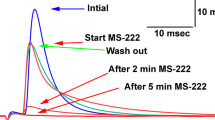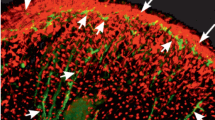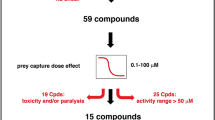Abstract
Sponges (Porifera) are nerve- and muscleless. Nevertheless, they react to external stimuli in a coordinated way, by body contraction, oscule closure or stopping pumping activity. The underlying mechanisms are still unknown, but evidence has been found for chemical messenger-based systems. We used the sponge Tethya wilhelma to test the effect of γ-aminobutyric acid (GABA) and glutamate (l-Glu) on its contraction behaviour. Minimal activating concentrations were found to be 0.5 μM (GABA) and 50 μM (l-Glu), respectively. Taking maximum relative contraction speed and minimal relative projected body area as a measure of the sponge’s response, a comparison of the dose–response curves indicated a higher sensitivity of the contractile tissue for GABA than for l-Glu. The concentrations eliciting the same contractile response differ by about 100-fold more than the entire concentration range tested. In addition, desensitising effects and spasm-like reactions were observed. Presumably, a GABA/l-Glu metabotropic receptor-based system is involved in the regulation of contraction in T. wilhelma. We discuss a coordination system for sponges based on hypothetical chemical messenger pathways.






Similar content being viewed by others
Abbreviations
- ANOVA:
-
Analysis of variance
- A r max :
-
Maximum relative projected area
- A r min :
-
Minimal relative projected area
- A r :
-
Relative projected area
- ΔA r :
-
Change of relative projected area
- c s :
-
Substance concentration
- GABA:
-
γ-Aminobutyric acid
- GABAAR, GABACR:
-
Ionotropic GABA receptors
- GABABR:
-
Metabotropic GABA receptor
- iGluR:
-
Ionotropic l-Glu receptors
- l-Glu:
-
l-Glutamic acid
- LSD:
-
Least significant difference
- mGluR:
-
Metabotropic l-Glu receptor
- P C :
-
Contracted phase
- P E :
-
Expanded phase
- v :
-
Contraction speed
- v C max :
-
Maximum relative contraction speed
- v E max :
-
Maximum relative speed of expansion
- v i max :
-
Maximum induced relative contraction speed
- ΔpH:
-
pH-shift
References
Aristotle (1498) De natura animalium libri novem; de partibus animalium libri quatuor; de generatione animalium libri quinqui. Electronic facsimile: Bibliotheque National de France: http://www.gallica.bnf.fr/Catalogue/NoticesInd/FRBNF37256929.html, Paris, pp 89
Bagby RM (1970) The fine structure of pinacocytes in the marine sponge Microciona prolifera. Z Zellforsch Mikroskop Anat 105:579–594
Bond C (1992) Continuous cell movements rearrange anatomical structures in intact sponges. J Exp Zool 263:284–302
Bond C, Harris AK (1988) Locomotion of sponges and its physical mechanism. J Exp Zool 246:271–284
Bouche N, Lacombe B, Fromm H (2003) GABA signaling: a conserved and ubiquitous mechanism. Trends Cell Biol 13:607–610
Chebib M, Johnston GAR (1999) The ‘ABC’ of GABA receptors: a brief review. Clin Exp Pharmacol Physiol 26:937–940
Chiu J, DeSalle R, Lam HM, Meisel L, Coruzzi G (1999) Molecular evolution of glutamate receptors: a primitive signalling mechanism that existed before plants and animals diverged. Mol Biol Evol 16:826–838
Davenport R (2002) Glutamate receptors in plants. Ann Bot 90:549–557
Ellwanger K, Nickel M (2006) Neuroactive substances specifically modulate rhythmic body contractions in the nerveless metazoon Tethya wilhelma (Demospongiae, Porifera). Front Zool 3:7
Emson RH (1966) The reactions of the sponge Cliona celata to applied stimuli. Comp Biochem Physiol 18:805–827
Fagg GE, Foster AC (1983) Amino acid neurotransmitters and their pathways in the mammalian central nervous system. Neuroscience 9:701–719
Fishelson L (1981) Observations on the moving colonies of the genus Tethya (Demospongia, Porifera): 1. behavior and cytology. Zoomorphology 98:89–100
Fitch R (2005) WinSTAT—the statistics add-in for Microsoft Excel release 2005.1, Staufen, Germany
Ito I, Watanabe S, Kimura T, Kirino Y, Ito E (2003) Distributions of gamma-aminobutyric acid immunoreactive and acetylcholinesterase-containing cells in the primary olfactory system in the terrestrial slug Limax marginatus. Zoolog Sci 20:1337–1346
Jones WC (1962) Is there a nervous system in sponges? Biol Rev 37:1–50
Kilian EF (1967) Ortsveränderungen von Süßwasserschwämmen unter dem Einfluß von Licht. Verh Dtsch Zool Ges 31(Suppl):395–401
Lentz TL (1968) Primitive nervous systems. Yale University Press, New Haven
Leys SP, Mackie GO (1997) Electrical recording from a glass sponge. Nature 387:29–30
Lieberkühn N (1859) Neue Beiträge zur Anatomie der Spongien. Arch Anat Physiol:353–358, 515–529
Mackie GO (1979) Is there a conduction system in sponges? In: Lévi C, Boury-Esnault N (eds) Biologie des Spongiaires. Editions du C.N.R.S., vol 291. C.N.R.S., Paris, pp 145–152
Mackie GO (1990) The elementary nervous system revisited. Am Zool 30:907–920
Madson P (2003) Digital camera remote shutter and digital camera time trigger. http://www.digital-camera.dk/
McNair GT (1923) Motor reactions of the fresh-water sponge Ephydatia fluviatilis. Biol Bull 44:153–166
Mezler M, Muller T, Raming K (2001) Cloning and functional expression of GABAB receptors from Drosophila. Eur J Neurosci 13:477–486
Nickel M (2001) Cell biology and biotechnology of marine invertebrates—Sponges (Porifera) as model organisms. Arb Mitteil Biol Inst Uni Stuttgart 32:1–157
Nickel M (2004) Kinetics and rhythm of body contractions in the sponge Tethya wilhelma (Porifera: Demospongiae). J Exp Biol 207:4515–4524
Nickel M (2006) Like a ‘rolling stone’: quantitative analysis of the body movement and skeletal dynamics of the sponge Tethya wilhelma. J Exp Biol 209:2839–2846
Nickel M, Brümmer F (2004) Body extension types of Tethya wilhelma: cellular organisation and their function in movement. Boll Mus Ist Biol Univ Genova 68:483–489
Nickel M, Leininger S, Proll G, Brümmer F (2001) Comparative studies on two potential methods for the biotechnological production of sponge biomass. J Biotechnol 92:169–178
Nickel M, Vitello M, Brümmer F (2002) Dynamics and cellular movements in the locomotion of the sponge Tethya wilhelma. Integr Comp Biol 42:1285
Nickel M, Donath T, Schweikert M, Beckmann F (2006) Functional morphology of Tethya (Porifera): 1. quantitative 3D-analysis of T. wilhelma by synchrotron radiation based x-ray microtomography. Zoomorphol 1–15 (online first)
Panek I, Torkkeli PH (2005) Inhibitory glutamate receptors in spider peripheral mechanosensory neurons. Eur J Neurosci 22:636–646
Panek I, Meisner S, Torkkeli PH (2003) Distribution and function of GABAB receptors in spider peripheral mechanosensilla. J Neurophysiol 90:2571–2580
Pantin CFA (1952) The elementory nervous system. Proc R Soc Lond B Biol Sci 140:147–168
Parker GH (1919) The elementory nervous system. Lippincot, Philadelphia
Pavans de Ceccatty M (1974) Coordination in sponges—the foundations of integration. Am Zool 14:895–903
Pavans de Ceccatty M (1979) Cell correlations and integrations in sponges. Biologie des Spongiaires 291:123–135
Pavans de Ceccatty M (1986) Cytoskeletal organization and tissue patterns of epithelia in the sponge Ephydatia mülleri. J Morphol 189:45–66
Perovic S, Krasko A, Prokic I, Mueller IM, Mueller WEG (1999) Origin of neuronal-like receptors in Metazoa: cloning of a metabotropic glutamate/GABA-like receptor from the marine sponge Geodia cydonium. Cell Tissue Res 296:395–404
Ramoino P, Fronte P, Beltrame F, Diasporo A, Fato M, Raiteri L, Stigliani S, Usai C (2003) Swimming behaviour regulation by GABAB receptors in Paramecium. Exp Cell Res 291:398–405
Ramoino P, Usai C, Beltrame F, Fato M, Gallus L, Tagliafierro G, Magrassi R, Diaspro A (2005) GABAB receptor intracellular trafficking after internalization in Paramecium. Microsc Res Tech 68:290–295
Rasband WS (1997–2005) ImageJ. National Institutes of Health, Bethesda, Maryland, USA, http://www.rsb.info.nih.gov/ij/
Reiswig HM (1971) In-situ pumping activities of tropical Demospongiae. Mar Biol 9:38–50
Richmond JE, Murphy AD, Lukowiak K, Bulloch AGM (1994) GABA regulates the buccal motor output of Helisoma by two pharmacologically distinct actions. J Comp Physiol A 174:593–600
Sarà M, Sarà A, Nickel M, Brümmer F (2001) Three new species of Tethya (Porifera: Demospongiae) from German aquaria. Stuttgarter Beitr Naturk Ser A 631:1–15
Schmidt O (1866) Zweites Supplement der Spongien des Adriatischen Meeres enthaltend die Vergleichung der Adriatischen und Britischen Spongiengattungen. Verlag von Wilhelm Engelmann, Leipzig
Schuske K, Beg AA, Jorgensen EM (2004) The GABA nervous system in C. elegans. Trends Neurosci 27:407–414
von Bohlen und Halbach O, Dermietzel R (2002) Neurotransmitters and neuromodulators. Wiley-VCH, Weinheim
Weissenfels N (1990) Condensation rhythm of fresh-water sponges (Spongillidae, Porifera). Eur J Cell Biol 53:373–383
Weyrer S, Rutzler K, Rieger R (1999) Serotonin in Porifera? Evidence from developing Tedania ignis, the Caribbean fire sponge (Demospongiae). Mem Queensland Mus 44:659–665
Wilson HV (1910) A study of some epitheloid membranes in monaxonid sponges. J Exp Zool 9:536–571
Xue H (1998) Identification of major phylogenetic branches of inhibitory ligand-gated channel receptors. J Mol Evol 47:323–333
Acknowledgments
We are grateful to Hans-Dieter Görtz and Franz Brümmer for their support of our research, Isabel Koch and Kai-Uwe Genzel for providing and maintaining sponges in the zoological Garden Wilhelma, Wolfgang Hauber for discussion on experimental design, Birgit Nickel and Markus Götz for discussion of results, Isabel Heim and Carsten Wolf for technical assistance with the aquarium. Our work was partly supported by the German Federal Ministry of Education and Research (BMBF) through the project Center of Excellence BIOTECmarin (F 0345D), by the Ministry of Science, Research and the Arts of the State of Baden-Württemberg and the University of Stuttgart. The experiments conducted herein comply with the current laws of Germany where they were performed.
Author information
Authors and Affiliations
Corresponding author
Additional information
K. Ellwanger and A. Eich contributed equally and designed and performed experiments, analysed data and revised the paper, M. Nickel designed the study and experiments, analysed data, prepared the figures, wrote and revised the paper.
Electronic supplementary material
Rights and permissions
About this article
Cite this article
Ellwanger, K., Eich, A. & Nickel, M. GABA and glutamate specifically induce contractions in the sponge Tethya wilhelma . J Comp Physiol A 193, 1–11 (2007). https://doi.org/10.1007/s00359-006-0165-y
Received:
Revised:
Accepted:
Published:
Issue Date:
DOI: https://doi.org/10.1007/s00359-006-0165-y




